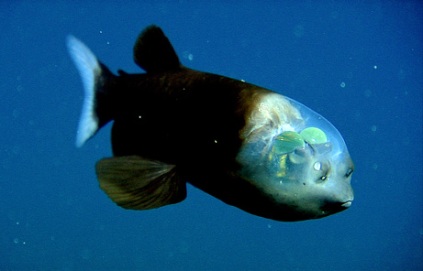Transparent-Headed Fish

“The beady bits on the front of the Pacific barreleye fish in this picture released February 23, 2009, aren’t eyes but smell organs. The grayish, barrel-like eyes are beneath the green domes, which may filter light. In this picture the eyes are pointing upward—the better to see prey above in the darkness of the barreleye’s deep-sea home. Since the eyes are upright tubes, “it just looked like [they only] looked straight up,” MBARI marine technician Kim Reisenbichler said. But by watching live fish from a remotely operated vehicle (ROV) and by bringing a barrelfish to an aquarium for study, the scientists discovered that the eyes can pivot, like a birdwatcher pointing binoculars.”

Smell Organs
Photograph courtesy Monterey Bay Aquarium Research Institute
The beady bits on the front of the Pacific barreleye fish in this picture released February 23, 2009, aren't eyes but smell organs.
The grayish, barrel-like eyes are beneath the green domes, which may filter light. In this picture the eyes are pointing upward--the better to see prey above in the darkness of the barreleye's deep-sea home.
Since the eyes are upright tubes, "it just looked like [they only] looked straight up," MBARI marine technician Kim Reisenbichler said. But by watching live fish from a remotely operated vehicle (ROV) and by bringing a barreleye to an aquarium for study, the scientists discovered that the eyes can pivot, like a birdwatcher pointing binoculars.

Deep Down
The barreleye lives more than 2,000 feet (600 meters) beneath the ocean's surface, where the water is almost inky.
The transparent-headed fish spends much of its time motionless, eyes upward, MBARI scientists discovered while watching the barreleye fish from a remotely operated vehicle.
The green lens atop each of the fish's eyes filters out what little sunlight makes it down from the surface, allowing the fish to focus on the bioluminescence of small jellies or other prey passing overhead.
Then the eyes rotate forward to follow the prey, allowing the fish to home in on its meal.

Barreleye Food Source?
Photograph courtesy Monterey Bay Aquarium Research Institute
The transparent-headed Pacific barreleyes may steal fish from siphonophores (such as this one photographed in 2001)—jellies that can grow to more than 33 feet (10 meters) long, according to researchers who released new barreleye findings and pictures on February 23, 2009.
The barreleye's flat, horizontal fins may allow it to swim very precisely among the siphonophore's stinging tentacles—and if the fish fumbles, the clear, helmet-like shield may protect its eyes, according to MBARI scientists.
Kredit : http://news.nationalgeographic.com

No comments:
Post a Comment